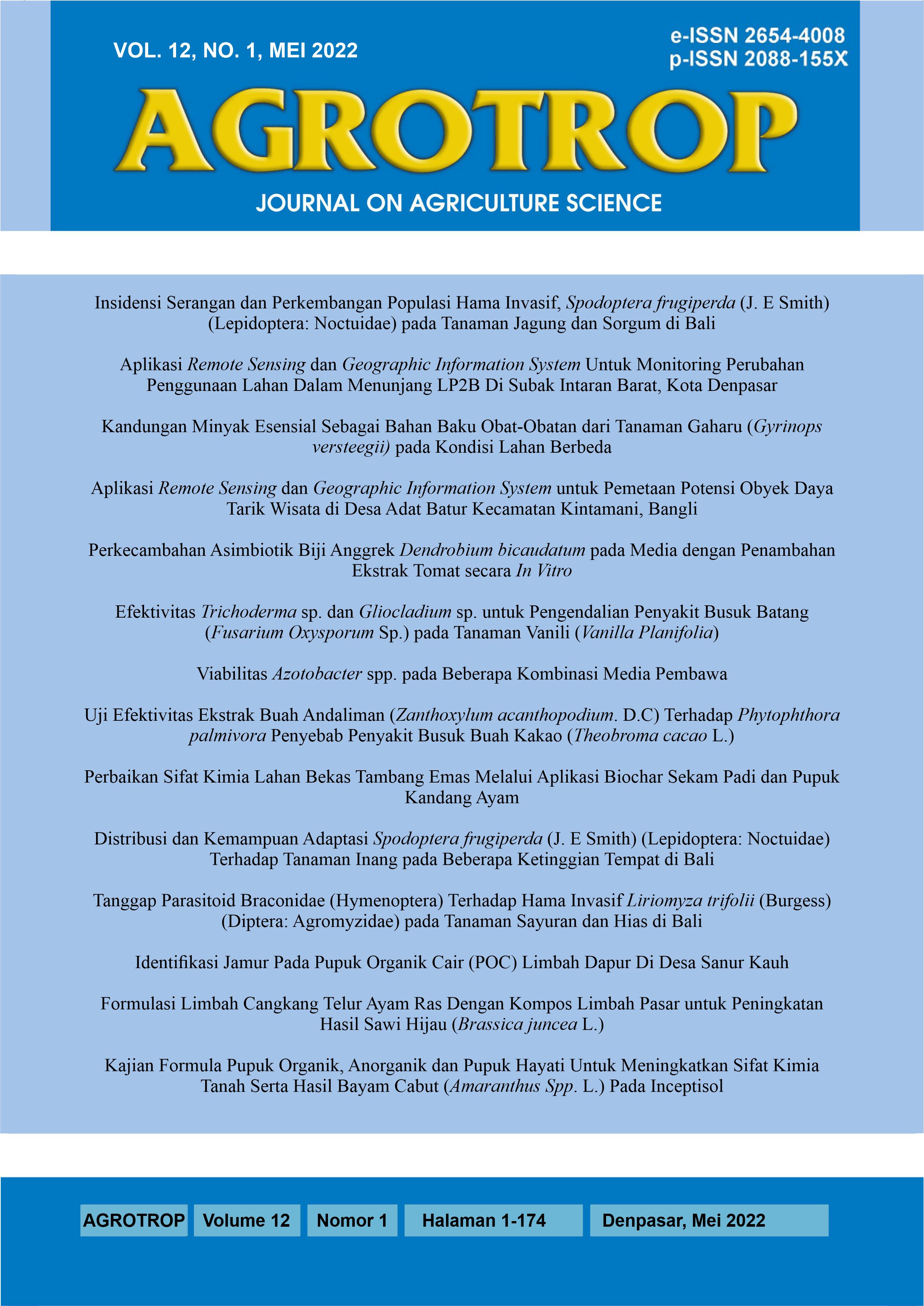Efektivitas Trichoderma sp. dan Gliocladium sp. untuk Pengendalian Penyakit Busuk Batang (Fusarium Oxysporum Sp.) pada Tanaman Vanili (Vanilla Planifolia)
Abstract
Effectiveness of Trichoderma sp. and Gliocladium sp. For Controlling Stem Rot (Fusarium Oxysporum sp.) in Vanilla (Vanilla planifolia). Vanilla (Vanilla planifolia Andrews) is one of the industrial plants that have very high economic value as an export commodity. One of the main obstacles to increasing vanilla production is stem rot disease. Stem rot disease caused by Fusarium oxysporum f. sp. vanillae became one of the main obstacles faced. This research on the effectiveness of antagonistic microbes aims to obtain the best antagonist microbes in suppressing stem rot disease in vanilla plants. The experiment was carried out in vitro at the Laboratory of Plant Diseases at Udayana University and in vivo at the Experimental Garden Greenhouse. The experiment used a randomized block design with six replications and four treatments, namely Control (without antagonistic microbes), G (Gliocladium sp. + compost), T (Trichoderma sp. + compost), and GT (Gliocladium sp. and Trichoderma sp. + compost). The results showed that T (Trichoderma sp. + compost) and GT (Gliocladium sp. and Trichoderma sp. + compost) able inhibit stem rot disease with the best percentage of 10%.
Downloads
References
Benitez, T., A. M. Rincon., M. C. Limon., and A. C. Codon. (2004). Biocontrol Mechanism of Trichoderma strains. International Microbiology 7: 249-260.
CMI Description of Pathogenic Fungi and Bacterial. (1981). Commonwealth Mycological Institute. England.
Departemen Pertanian. (2011). Pengendalian Jamur Fusarium oxysporum. Hortikultura budidaya fusarium-antagonis.pdf. Diakses tanggal 25 Desember 2020.
Freeman, S., A. Zveibel., H. Vintal & M. Maymon. (2002). Isolation of nonpathogenic mutants of Fusarium oxysporum f.sp. melonis for biological control of Fusarium wilts in cucurbits. Phytopathology 92: 164-168.
Ganik, R. (2013). Kecernaan In Vitro Bahan Kering dan Bahan Organik Jerami Jagung (Zea mays) yang Diinokulasikan dengan Trichoderma sp. pada lama inkubasi yang berbeda. Makasar.
Harahap, H. (1987). Potensi pengembangan panili di Indonesia. Seminar Pengembangan Panili Melalui Pola PIR di Denpasar Bali. Paper. 14 hlm.
Novita, Trias. (2011). Trichoderma sp. dalam Pengendalian Penyakit Fusarium pada Tanaman Tomat. Biospecies 4(2) :27-29.
Pinem, M. I., W. Sipaung. (2001). Peran Agens Antagonis dalam Pengendalian Hayati. Dalam Pelatihan Agens Hayati untuk Pengendalian Organisme Pengganggu Tanaman (OPT) Perkebunan Kakao. Hal 20-25.
Purwantisari, S & R.B. Hastuti. (2009). Uji antagonisme jamur patogen Phytophthora infestans penyebab penyakit busuk daun dan umbi tanaman kentang dengan menggunakan Trichoderma spp. isolat lokal. Jurnal Bioma 11(1): 24–32.
Rosman, R. (1986). Kemungkinan pengembangan tanaman vanili di Pulau Jawa dan Madura ditinjau dari segi kesesuaian lahan dan iklim. Balai Penelitian Tanaman Rempah dan Obat, Bogor.
Sudana, M., G. R. M. Temaja, G. N. A. S. Wirya, P. Sudiarta. (2012). Penuntun praktikum bioteknologi perindungan tanaman. Denpasar.
Sudantha, I. M. (2010). Pengujian beberapa jenis jamur endofit dan saprofit Trichoderma spp. terhadap penyakit layu Fusarium pada tanaman kedelai. Jurnal Ilmu Pertanian Agroteksos, 20: 2-3.
Suryawan. (2017). Penggunaan Trichoderma sp. yang ditambahkan pada Berbagai Kompos untuk Pengendalian Penyakti layu Tanaman Stroberi (Fragaria sp.)
Thomas J, AK. Vijayan., RS. Bhai. (2002). Vanilla disease in India and their management. Indian Journal of Arecanut Spices &Medical Plants 4, 143-149.
Winarsi H. (2007). Antioksidan alami dan radikal bebas potensi dan alikasinya dalam kesehata. Yogyakarta. Kanisius.











